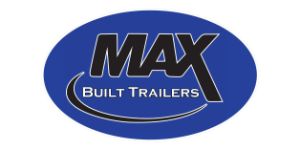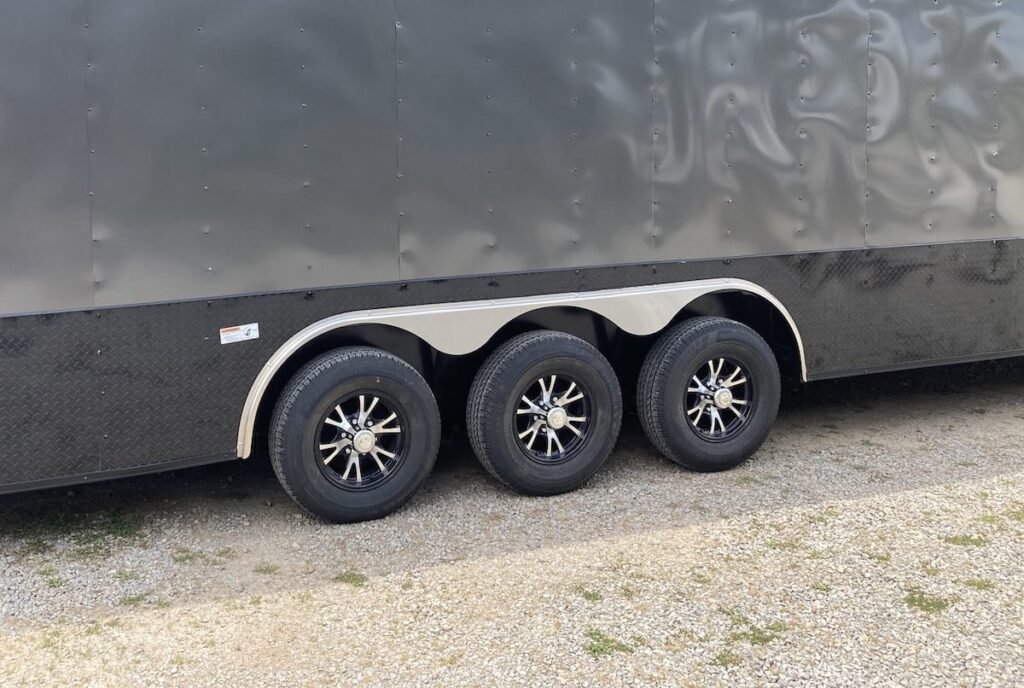Cargo trailers are the staples for countless industries, silently ferrying goods across highways and byways and helping to power the very heartbeat of our economy. Yet, amidst their pivotal role lies a critical component often overlooked: tires. These essential pieces of rubber not only support the weight of commerce but also bear the responsibility of ensuring safe and efficient transportation. In this comprehensive guide, we delve into the realm of cargo trailer tire safety to help keep our readers on the road. If you have any questions about your tires, contact our trailer supply and parts department.
Selecting the right wheels and tires for your trailer is criticall for its performance and safety. When you need to replace your trailer tires and rims, it’s essential to choose the correct size and load capacity to match your trailer’s needs. Here are some key factors to consider:
- Tire Construction Type: Decide between bias ply and radial tires—each with its own advantages and suitability for different applications.
- Tire Application Type: Determine if you need special trailer (ST) tires or if passenger car (P) tires are appropriate for your trailer.
- Tire Size: Look at the section height as a percentage of the section width, also known as the aspect ratio. This helps you understand the tire’s dimensions.
- Tire Load Range: Consider the tire’s load-carrying capacity and air pressure rating to ensure it can support the weight of your trailer and its cargo.
- Rim Size: Make sure the diameter and width of the rim match the tire for proper fitting.
- Rim Bolt Circle: Check that the diameter of the bolt circle on the rim matches the hub of your trailer axle for secure attachment.
Understanding tire specifications can be confusing—especially with different size identification systems. Here’s a breakdown:
- Numeric System: Used for smaller trailer tires, such as “4.80 X 8”, indicating the tire’s section width (4.80 inches) and rim diameter (8 inches).
- Alpha Numeric System: Common for 13″ to 15″ trailer tires, like “B78 X 13 C”, which represents the air chamber size (B), aspect ratio (78), rim diameter (13 inches), and load range (C).
- Metric System: Increasingly used by trailer tire manufacturers, like “ST205 75D 15”, showing the tire application type (ST), section width (205mm), aspect ratio (75), construction type (D for bias ply), and rim diameter (15 inches).
Selecting the right trailer rims is also crucial to ensure they match your existing trailer hardware. Make sure the wheel’s bolt circle pattern matches the hub of your trailer axle for proper installation and alignment.
How long do trailer tires last?
Regardless of whether it’s a utility trailer, equipment trailer, enclosed trailer, tilt trailer or dump trailer, tires endure constant weight—even during periods of inactivity. Regular use helps distribute lubricants essential for tire longevity and prevents flat spots. Tires are meant to be rolling!
Proper Inflation: Improper tire inflation is the leading cause of tire failure. Check tire pressure weekly when during cold temperatures and adjust according to the trailer manufacturer’s recommendations to maintain load-carrying capacity and handling.
Air Loss Over Time: Tires naturally lose air at a rate of 1 to 3 PSI per month due to molecular diffusion through the rubber, so it’s extremely important to check your tire pressures regularly. Underinflation can lead to internal damage and overheating.
High-Speed Towing Caution: Towing at high speeds in hot conditions accelerates tire degradation—compromising tire strength. Keeping your speed under 60 mph is advised when towing unless you’re using tires rated for higher speeds and temperatures..
Tire Lifespan: Trailer tires typically last around five years with proper maintenance. Consider replacement every three years, regardless of tread depth, and have tires inspected by professionals if unsure.
Storage Considerations: When storing your trailer for extended periods, maintain maximum rated tire pressure and shield tires from sunlight with covers in a cool, dry environment.
How to determine trailer tire load limits
Federal Certification Label: Locate the label on the trailer’s left side indicating Gross Vehicle Weight Rating (GVWR) and Gross Axle Weight Rating (GAWR) to understand weight limits.
Placard Information: The placard information refers to the details typically found on a label attached to trailers, providing essential data regarding tire size, inflation pressure, vehicle capacity weight (VCW) and GAWR. This placard is usually located in a prominent position, often near the trailer’s left front side, and serves as a reference point for trailer owners and operators to ensure they are within safe operating parameters regarding tire usage and load capacities. For trailers under 10,000 pounds GVWR, a placard provides tire and loading information—including maximum cargo capacity.
Even Distribution: Ensure even distribution of cargo to prevent overloading and maintain balance. Weighing the fully loaded trailer at a public scale is recommended for accurate assessment.
Basic Tire Maintenance Tips
Tire maintenance should go beyond basic checks and incorporate proactive measures to ensure and maintain tire performance, longevity and safety. Here’s a comprehensive guide to advanced tire maintenance:
Tire Rotation:
Regularly rotate tires according to the manufacturer’s recommendations to ensure even wear patterns. This extends tire life and maximizes performance. Rotations should typically occur every 6,000 to 8,000 miles or as specified in the owner’s manual.
Wheel Alignment:
Schedule periodic wheel alignments to ensure proper tire contact with the road surface. Misaligned wheels can cause uneven tire wear and compromise vehicle handling. A qualified technician should perform alignments using precision equipment.
Tire Balancing:
Balancing tires minimizes vibration and ensures smooth operation. Unbalanced tires can lead to uneven wear and premature failure. Have tires balanced whenever they are mounted on rims or if vibrations are experienced while driving.
Tire Load Index and Speed Rating:
Respect the tire’s load index and speed rating when selecting replacements. These ratings indicate the maximum load capacity and speed capability of the tire. Exceeding these limits can result in tire failure and compromise safety.
Tire Storage:
Store spare tires in a cool, dry environment away from direct sunlight and sources of heat. Elevated temperatures can accelerate tire aging and deterioration. Use tire covers to shield tires from UV radiation and ozone exposure.
Tire Cleaning and Inspection:
Regularly clean tires with mild soap and water to remove dirt, debris and corrosive substances. Inspect tires for signs of damage—such as cuts, bulges or punctures—and address any issues promptly. Use a tire dressing to condition and protect the rubber.
Tire Pressure Monitoring System (TPMS):
Invest in a TPMS to monitor tire pressure in real-time and receive alerts for low-pressure conditions. The TPMS enhances safety by providing early warnings of potential tire failures or underinflation events.
Nitrogen Inflation:
Consider inflating tires with nitrogen instead of compressed air. Nitrogen offers stable pressure and reduces moisture content—minimizing tire degradation and improving longevity. Many tire shops offer nitrogen inflation services.
Tire Retreading:
Explore retreading options for commercial vehicle tires to extend their service life and reduce operating costs. Retreading involves applying a new tread to a worn tire casing, offering a cost-effective and environmentally friendly alternative to tire replacement.
Tire Insurance and Warranty:
Consider purchasing tire insurance or opting for tires with extended warranties to protect against unexpected damage or premature wear. Review the terms and coverage details carefully to ensure comprehensive protection.
By incorporating these advanced tire maintenance practices into your routine, you can optimize tire performance, enhance safety and prolong the lifespan of your tires—ultimately maximizing the value of your investment and ensuring worry-free travels.
What PSI should trailer tires be?
This is going to vary by vehicle, trailer and tire. It’s recommended you check all appropriate owner’s manuals and vehicle information and trailer placards. Refer to placards or certification labels for tire size, inflation pressure, vehicle capacity weight and axle weight ratings.
Understanding Tire Pressure and Load Limits
Inflation Importance: Tire pressure affects load-carrying capacity and overall vehicle performance. Manufacturers determine recommended cold inflation pressure based on design load limits and tire size.
Tire Pressure Checks: Regularly check tire pressure—especially when cold—using a tire pressure gauge to ensure proper inflation.
Sidewall Information: Federal law mandates standardized information on tire sidewalls, including fundamental characteristics and a tire identification number for safety and recall purposes.
Tire Size, Tread, Balance, and Repair
Choosing Correct Tire Size: Replace tires with sizes recommended by the manufacturer to ensure safety and performance.
Monitoring Tread Depth: Replace tires when tread depth reaches 2/32 of an inch, indicated by built-in tread wear indicators or the “penny test” (see below).
Balancing and Alignment: Properly balance and align tires to prevent vibration and maximize tire life. Seek professional assistance for these adjustments.
Repairing Punctures: Punctured tires can be repaired with plugs and patches if the damage is not extensive, but sidewall punctures require replacement.
How to do the “Penny Test”
The penny test is a simple and effective method used to check tire tread depth and determine if tires need replacement. Here’s how to perform the penny test:
- Take a penny and hold it with Abraham Lincoln’s head facing downward.
- Insert the penny into the tread groove of the tire—with Lincoln’s head pointing toward the tire.
- Ensure that the penny is inserted with Lincoln’s head first and that his head is upside down.
- Observe how much of Lincoln’s head is visible above the tread.
- If the top of Lincoln’s head is fully visible, meaning you can see his entire head, then the tire tread depth is less than 2/32 of an inch.
- If part of Lincoln’s head is covered by the tread, meaning the tread reaches at least to the top of Lincoln’s head, then the tire has adequate tread depth.
- Repeat the test in multiple locations across the tire to check for uneven wear.
If the tread depth is insufficient (Lincoln’s head is fully visible), it’s a sign that the tire is worn and may not provide adequate traction—especially in wet or slippery conditions. In such cases, it’s advisable to replace the tire to ensure safe driving.
Where to buy trailer tires
Our trailer supply and parts department can help you with any issues your trailer tires may have.
Sources:
National Highway Traffic Safety Administration (NHTSA) – Tire Safety Information
Tire Industry Association (TIA) – Tire Safety
Rubber Manufacturers Association (RMA) – Tire Safety
U.S. Department of Transportation (DOT) – Tire Safety Brochure





